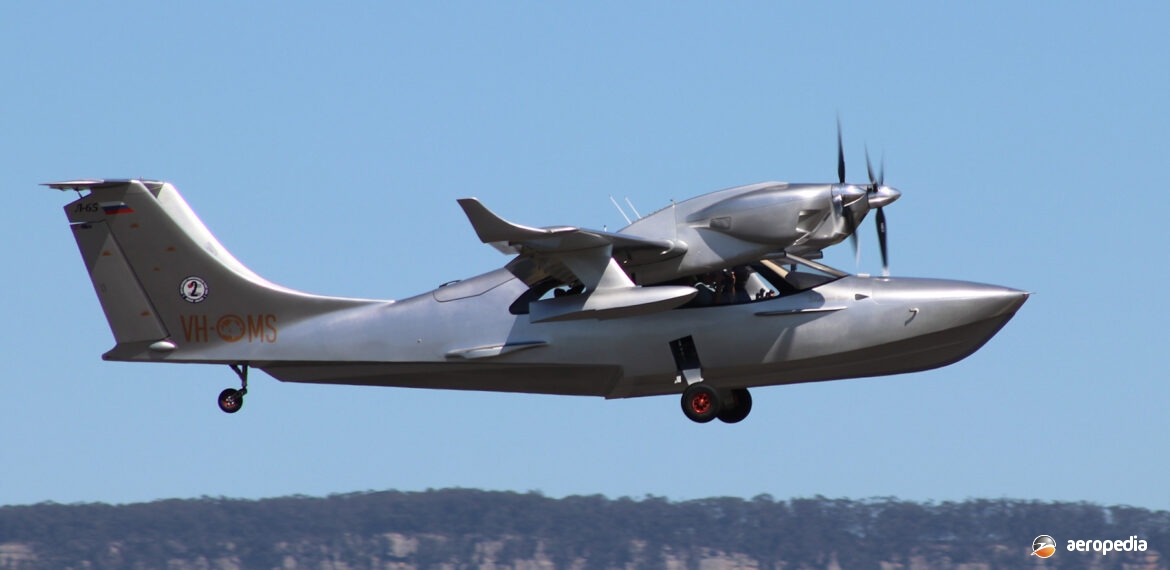Photograph:
Chaika SeaBear VH-OMS (c/n L65-001) at Albion Park, NSW in April 2020 (David C Eyre)
Country of origin:
Russia
Description:
Four-seat, twin-engine amphibious flying boat
Power Plant:
Two 86 kw (115 hp) Rotax 914 ULF four-cylinder horizontally-opposed liquid and air-cooled engines
Specifications:
- Wingspan: 13.50 m (44 ft 3 in)
- Length: 8.50 m (27 ft 11 in)
- Height: 2.52 m (8 ft 3 in)
- Wing area: 22.45 m² (241.6 sq ft)
- Never exceed speed: 250 km/h (160 mph)
- Max speed: 225 km/h (140 mph)
- Cruising speed: 180 km/h (110 mph)
- Service ceiling: 4,000 m (13,000 ft)
- Max rate of climb: 305 m/min (1,000 ft/min)
- Take-off run: 250 m (820 ft)
- Landing distance, land and water: 150 m (500 ft)
- Range: 1,598 km (993 miles)
- Fuel capacity: 500 litres (110 Imp gals)
- Empty weight: 830 kg (1,830 lb)
- Fuel capacity: 230 kg (507 lb)
- Useful load: 630 kg (1,390 lb)
- Loaded weight: 1,460 kg (3,219 lb)
History:
The SeaBear was designed by G Annenkov and a team of graduates from the Samara State Aerospace University in Russia and more than 30 examples have been delivered. It has been based on a project in collaboration with the Central Aerohydrodynamic Institute (TsAGI). The team commenced design of light aircraft in 1986. First model was the L-42 fitted with 75 kw (100 hp) Rotax 912 engines but the aircraft since 2000 has been developed through the L-6, the L-42, L-44 and L-45 and examples have been shown at eastern Europe airshows, including the International Aviation and Space Salon at Zhukovsky near Moscow.
The aircraft is built by Chaika at Samara and was aimed at operating in the Siberian region, being required to operate with no airports in parts of Siberia and able to operate from lakes, rivers and snowfields; testing of the six-seat variant being carried out in collaboration with the Siberian Aeronautical Research Institute. The cabin is designed with side-by-side seating, entrance to the aircraft being through a door at the rear upper part of the fuselage. Development has moved on to the L-45, this model utilizing the Rotax 915iS engine which provided 104 kw (140 hp). Construction is all composite, the engines being mounted close to the fuselage on top of the wing. The hull has two steps and there are small winglets at water level to the rear of the trailing edge.
The aircraft has twin fins mounted on the fuselage and these extended forward with dorsal fillets separate at the rear fuselage and which lean slightly outwards, these carrying conventional rudders and the tailplane and is mounted at the top of the fins. The spine of the fuselage acts as a walkway to access the aircraft from the shore. It has a normal tailwheel undercarriage, which is retractable, as is the water rudder. First flight of the L-4 series took place in June 2005.
Advertising states the aircraft with its 500 litre (110 Imp gals / 132 US gals) fuel capacity technically has the ability to stay airborne for 12.5 hours and giving a range of 2,500 km (1,553 miles). Cabin width is 1.26 m (50 inches) and cabin height is 1.39 m (55 inches). The rear seats can be folded to accommodate freight or can be converted into sleeping seats.
In October 2017 Australian pilot and adventurer Michael Smith circumnavigated the world in his Progressive Aerodyne SeaRey and was later named the Adventurer of the Year by the Australian Geographic magazine. In 2019 Mr Smith obtained a SeaBear fitted with Rotax 915 engines to re-enact the flight of the Vickers Vimy G-EAOU from the United Kingdom to Australia in 1919, leaving from Britain and arriving in Darwin on 10 December 2019 and then continuing to Adelaide accompanied by a fleet of other light aircraft. On 29 October 2019 this aircraft, described as a Chaika LLC L65 Seabear became VH-OMS (c/n L65-001) registered to and operated by the MGS Group Pty Ltd of Yarraville, VIC. It was followed by VH-YWN (c/n L45-025) registered in August 2022.

